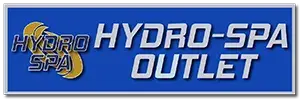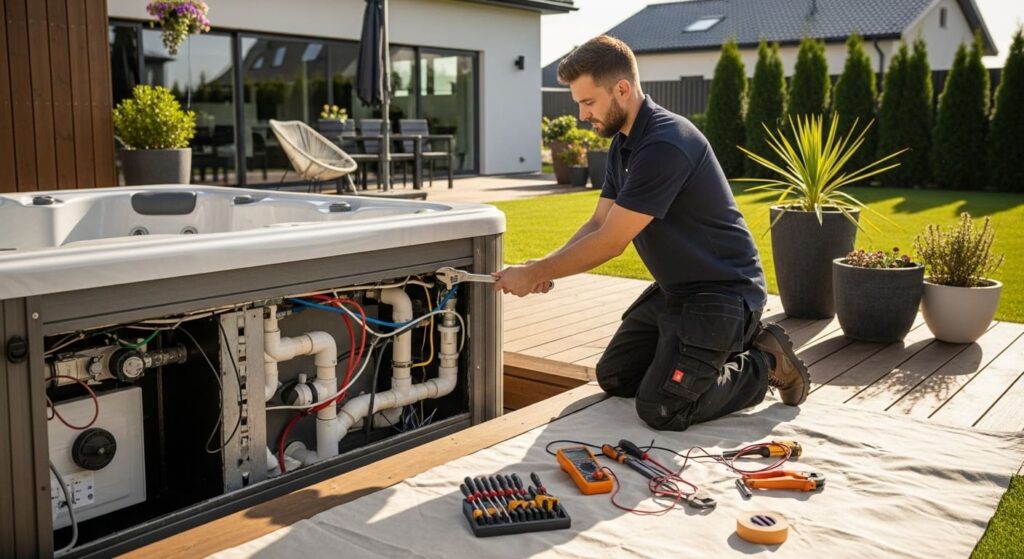Keeping hot tub water comfortable and crystal clear in Woodland Hills is a satisfying blend of science and local know-how. Our neighborhood’s warm afternoons, cool evenings, and occasional bursts of dry wind can nudge water chemistry more than you might expect, and our mineral-rich fill water adds its own twist. The result is a delightful challenge: choose the right chemicals, use them wisely, and let a steady routine do most of the work. If you ever feel unsure about an unusual reading or a change in water feel, local help for hot tub repair and system evaluation keeps everything on track so you can get back to relaxing.
The good news is that hot tub chemistry doesn’t have to be complicated. Once you understand the roles of sanitizer, pH, alkalinity, and calcium hardness, the rest becomes intuitive. The trick is to interpret what your spa is telling you. If the water feels dull or leaves your skin tight, you might be seeing the effect of hard water or a pH that drifted high after a week of warm, sunny afternoons. If the water looks clear but smells off, it may be asking for an oxidizing shock to burn off what sanitizer alone isn’t handling. These small insights, applied consistently, are the backbone of easy care in our Valley.
Sanitizers: Chlorine, Bromine, and Supporting Players
Sanitizer is your primary defender, quietly neutralizing the things that don’t belong in your spa. In Woodland Hills, both chlorine and bromine can perform beautifully when used correctly. Chlorine is nimble and familiar, responding quickly to changes in bather load and sunlight. Bromine shines in hot water environments and resists pH swings a bit better, which some homeowners find forgiving. Either choice benefits from a stable supporting cast: balanced alkalinity to buffer pH, and consistent testing so you know where you actually stand.
Some systems add ozone or UV to ease the workload on traditional sanitizers. These tools don’t replace sanitizer; they support it, helping to oxidize contaminants so your residual level can remain steady. If your spa includes such features, you may notice that routine additions are lighter, especially when usage is consistent and the cover is in good condition. The aim is not just cleanliness but comfort—water that feels gentle on skin and doesn’t carry an after-smell.
pH and Alkalinity: The Balance That Makes Comfort Obvious
pH and alkalinity are the quiet pair that keep sanitizer effective, and water feels pleasant. Alkalinity acts as a buffer, reducing the tendency of pH to swing with every passing breeze or soak session. In Woodland Hills, where evaporation can be significant during dry spells, these parameters can drift faster than you anticipate. Keeping alkalinity in a supportive range helps pH settle where sanitizer does its best work and where the water feels welcoming rather than sharp.
If you find yourself chasing pH—up one week, down the next—it’s often a sign that alkalinity needs a thoughtful nudge. Once the buffer is steady, pH responds calmly to small adjustments. And when pH is right, sanitizer feels more efficient, the water looks brighter, and the overall experience is more enjoyable.
Calcium Hardness in a Mineral-Rich Area
Our local fill water frequently arrives with a respectable dose of minerals, and over time those minerals concentrate as water heats, cools, and evaporates. Appropriate calcium levels are important; too low and water can feel aggressive, seeking minerals from surfaces, and too high and it can leave scale on heaters and around jets. The sweet spot creates a silky feel and protects equipment. If your readings climb, there are ways to manage them—partial drains and refills, products designed to bind minerals, and, importantly, preventing pH from staying high, which encourages scale to settle.
Once you learn how your spa behaves between top-offs and routine soaking, you can anticipate when calcium readings might rise and plan accordingly. That foresight is one of the small skills that make hot tub ownership feel easy rather than reactive.
Shock: The Reset Button After Busy Use
Even when sanitizer is steady, organic material can build up in the water, especially after gatherings or repeated soaks. Shock treatments—oxidizers that burn away what sanitizer doesn’t handle well—restore clarity and remove lingering odors. Non-chlorine shock is popular because it works without leaving a noticeable chlorine scent, and it’s friendly to both chlorine and bromine systems. Timing matters; many homeowners find that a post-weekend shock followed by balanced sanitizer the next day delivers the clearest, freshest water with the least effort.
Think of shock as a maintenance tool, not a fix-all. If the underlying balance of pH and alkalinity is off, shock alone won’t deliver lasting clarity. It’s most effective when used as part of a consistent chemistry routine that respects how your spa is actually used.
Specialty Helpers: Enzymes, Clarifiers, and Line Cleaners
Some products are optional but helpful in our area. Enzymes can digest residual oils from sunscreen and lotions—common companions in sunny Woodland Hills backyards. Clarifiers help microscopic particles gather so filters can remove them, especially after windy days that drive fine dust into open water. Line cleaners, used occasionally before a drain-and-refill, purge biofilm from plumbing so fresh water starts in a clean environment. None of these are mandatory, but each can simplify care when matched to your habits.
If you notice recurring foam or a persistent ring at the waterline, a short run with enzymes paired with a careful wipe-down can break the cycle. If your water looks clear but seems to sparkle less than usual, a gentle clarifier may nudge your filters to finish the job. Use these tools sparingly and observe. Your spa will tell you whether they’re doing what you hoped.
Reading Your Water Like a Local
Water speaks through small signs. A faint, sweet odor after heavy use asks for oxidation. A slight cloudiness that lingers even when tests look good suggests fine debris waiting for filters to catch. A dry feeling on the skin after soaking hints at high pH or mineral presence. When you match these signals to your toolkit—sanitizer, pH and alkalinity adjustments, shock, and occasional helpers—your spa remains serene, even through our seasonal swings.
Experience helps, and so does a second set of trained eyes when something doesn’t add up. That’s where a local pro can complement your routine, offering a quick calibration or a deeper inspection if unusual readings refuse to settle. Keeping that option handy makes ownership more relaxing.
Storage, Safety, and Smart Handling
Chemicals are most effective—and most predictable—when stored correctly. In Woodland Hills, garages and sheds can heat up in summer, so choose a cool, dry spot and keep containers tightly sealed. Avoid mixing products or reusing scoops between containers without washing them thoroughly. Add chemicals with pumps running so they disperse quickly, and give each addition time to circulate before testing again. These simple habits support stable water and protect your equipment.
Take a moment to read labels and respect manufacturer guidance. When in doubt, start with smaller doses and retest rather than making large corrections. Slow, steady adjustments are the fastest path to clear, comfortable water.
Mid-Season Tune-Ups and Professional Support
As weather pivots—from spring pollen to summer sun or from autumn breezes to winter evenings—your spa may benefit from a mid-season tune-up. A professional can verify readings with more precise tools, assess calcium scaling potential, and offer suggestions that account for your backyard’s specific quirks. If something more than chemistry is at play—a sluggish pump, a heater that struggles to keep up—timely hot tub repair ensures your water chemistry efforts aren’t fighting mechanical headwinds.
That collaboration doesn’t have to be frequent. Even occasional guidance gives you confidence that your routine is aimed in the right direction. You’ll notice it in the way your spa feels and the ease with which it stays balanced.
Environmental Considerations for Our Valley
When it’s time for partial drains or refills to manage minerals or total dissolved solids, plan with care. Choose cooler parts of the day to reduce heat stress on equipment and surrounding landscaping. Be mindful of where water flows, especially if you have sloped terrain common in parts of Woodland Hills. Returning fresh water to a system that’s been thoughtfully purged and balanced gives you a clean starting line for the next season of soaks.
Every small choice—cover closed when not in use, filters rinsed before they’re clogged, chemistry managed gently—reduces the overall strain on your spa and minimizes waste. The result is water that looks, feels, and smells inviting without overcomplication.
Frequently Asked Questions
1. Which sanitizer is best for Woodland Hills homes?
Both chlorine and bromine perform well here. Chlorine responds quickly to changes in use and sunlight, while bromine can feel more stable at higher temperatures. Choose based on your comfort level and how your spa behaves. Either way, support the sanitizer with steady pH and alkalinity.
2. How do I handle hard water?
Test calcium hardness regularly, especially after top-offs. Keep pH from drifting high, consider mineral-binding products when readings creep up, and plan periodic partial drains to reset levels. Managing minerals proactively protects heaters and jets and improves water feel.
3. Do I need to shock every week?
Not necessarily. Shock when usage is heavy or when you notice lingering odors or dull water. Many homeowners find a weekly or post-weekend shock works well, but let your spa’s behavior lead the schedule rather than a strict rule.
4. Why does my waterline keep getting a ring?
Lotions, sunscreen, and natural oils collect at the surface and cling to the shell. A quick wipe after heavy use, occasional enzyme support, and balanced chemistry keep that ring from establishing itself.
5. Can specialty products replace a good balance?
No. They’re helpers, not substitutes. Enzymes, clarifiers, and line cleaners work best when sanitizer, pH, alkalinity, and calcium are already in range. Start with the fundamentals, then add specialty products only if your spa suggests it.
6. When should I involve a professional?
If you see recurring issues, unusual readings that don’t respond to careful adjustments, or equipment behavior that seems off, a local expert can quickly pinpoint the cause. Coordinating chemistry with system health—and arranging timely hot tub repair when needed—keeps your spa serene.
Enjoy Effortless, Comfortable Water
With the right chemicals used in a steady, thoughtful way, your Woodland Hills hot tub becomes a simple pleasure that rarely asks for attention. If you’d like guidance tailored to your backyard and usage, or if you want a second set of eyes on unusual readings, reach out to a trusted local team. When it’s time to fine-tune performance or tackle a stubborn issue, expert hot tub repair is nearby—so your next soak feels as perfect as the view from your own patio.
Maintain Perfect Water Quality with Hydro-Spa Outlet
Protect your spa and enjoy clean, safe water with the right repair chemicals. Contact Hydro-Spa Outlet in Woodland Hills, California, for professional guidance, premium products, and expert hot tub maintenance support.
Read more:
Hot Tub Repair Pump Inspection in Woodland Hills California
Professional Hot Tub Repair Service in Woodland Hills California

